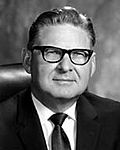| No. | Dates | Presiding Bishop | First Counselor | Second Counselor |
|---|
| 1 | February 4, 1831 – May 27, 1840 | Edward Partridge
("Bishop") |  | Isaac Morley
(June 6, 1831 – May 27, 1840) |  | John Corrill
(June 6, 1831 – August 1, 1837)
Titus Billings
(August 1, 1837 – May 27, 1840) | |
| May 27, 1840 – October 7, 1844 | None sustained |
| October 7, 1844 – April 6, 1847 | Newel K. Whitney
("First Bishop of the Church") |  | Reynolds Cahoon
(1832–?) [5] : 35
George Miller
("Second Bishop of the Church")
(October 7, 1844 – latter end of 1846) [6] | |
| 2 | April 6, 1847 – September 23, 1850 | Newel K. Whitney
("Presiding Bishop") | None |
| 3 | April 7, 1851 – October 16, 1883 | Edward Hunter |  | Leonard W. Hardy
(October 6, 1856 – October 16, 1883) |  | Jesse C. Little
(October 6, 1856 – Summer 1874)
Robert T. Burton
(October 9, 1874 – October 16, 1883) | |
| 4 | April 6, 1884 – December 4, 1907 | William B. Preston |  | Leonard W. Hardy
(April 6, 1884 – July 31, 1884)
Robert T. Burton
(October 5, 1884 – November 11, 1907) | | Robert T. Burton
(April 6, 1884 – October 5, 1884)
John Q. Cannon
(October 5, 1884 – September 5, 1886)
John R. Winder
(April 8, 1887 – October 17, 1901)
Orrin P. Miller
(October 24, 1901 – December 4, 1907) | |
| 5 | December 4, 1907 – May 28, 1925 | Charles W. Nibley |  | Orrin P. Miller
(December 4, 1907 – July 7, 1918)
David A. Smith
(July 18, 1918 – May 28, 1925) | | David A. Smith
(December 4, 1907 – July 7, 1918)
John Wells
(July 18, 1918 – May 28, 1925) | |
| 6 | June 4, 1925 – April 6, 1938 | Sylvester Q. Cannon |  | David A. Smith |  | John Wells |  |
| 7 | April 6, 1938 – April 6, 1952 | LeGrand Richards |  | Marvin O. Ashton
(April 6, 1938 – October 7, 1946)
Joseph L. Wirthlin
(December 12, 1946 – April 6, 1952) | | Joseph L. Wirthlin
(April 6, 1938 – October 7, 1946)
Thorpe B. Isaacson
(December 12, 1946 – April 6, 1952) | |
| 8 | April 6, 1952 – September 30, 1961 | Joseph L. Wirthlin |  | Thorpe B. Isaacson |  | Carl W. Buehner |  |
| 9 | September 30, 1961 – April 6, 1972 | John H. Vandenberg |  | Robert L. Simpson |  | Victor L. Brown |  |
| 10 | April 6, 1972 – April 6, 1985 | Victor L. Brown |  | H. Burke Peterson | | Vaughn J Featherstone
(April 6, 1972 – October 1, 1976)
J. Richard Clarke
(October 1, 1976 – April 6, 1985) | |
| 11 | April 6, 1985 – April 2, 1994 | Robert D. Hales | | Henry B. Eyring
(April 6, 1985 – October 3, 1992)
H. David Burton
(October 3, 1992 – April 2, 1994) | | Glenn L. Pace
(April 6, 1985 – October 3, 1992)
Richard C. Edgley
(October 3, 1992 – April 2, 1994) | |
| 12 | April 2, 1994 – December 27, 1995 | Merrill J. Bateman | | H. David Burton | | Richard C. Edgley | |
| 13 | December 27, 1995 – March 31, 2012 | H. David Burton | | Richard C. Edgley | | Keith B. McMullin | |
| 14 | March 31, 2012 – October 9, 2015 | Gary E. Stevenson |  | Gérald Caussé |  | Dean M. Davies | |
| 15 | October 9, 2015 – November 14, 2025 | Gérald Caussé |  | Dean M. Davies (October 9, 2015 – October 3, 2020) W. Christopher Waddell (October 3, 2020 – November 14, 2025) | | W. Christopher Waddell (October 9, 2015 – October 3, 2020) L. Todd Budge (October 3, 2020 – November 14, 2025) | |
| 16 | November 14, 2025 – present | W. Christopher Waddell | | L. Todd Budge (November 14, 2025 – present) | | Sean Douglas (November 14, 2025 – present) |



























